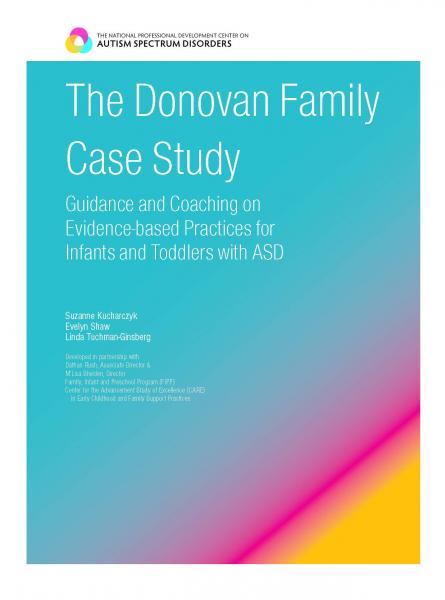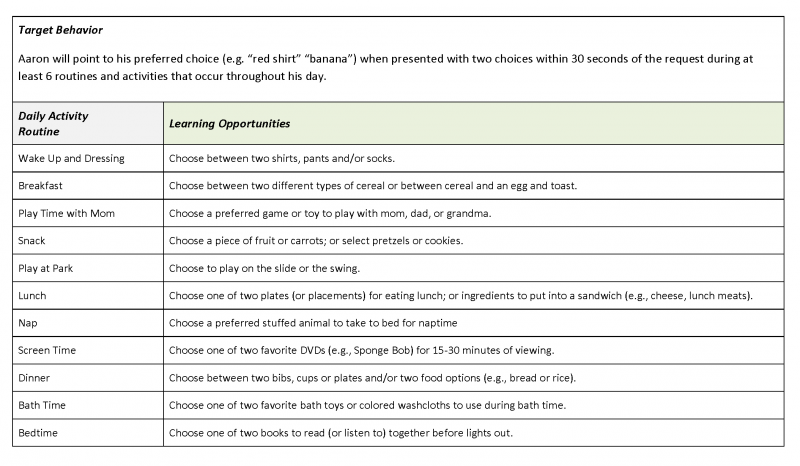Step 1.3 Identify the contexts for intervention
Naturalistic intervention takes place throughout the day in the context of daily routines and activities. Being intentional about implementing interventions within the context of a toddler’s regular routines and activities is critical for successfully implementing naturalistic intervention.
a) Determine the toddler’s schedule of typical routines and activities
This includes activities in home, center, and other community settings. The schedule is often done on a weekly basis. Consider that all families have activities, but they may or may not occur in the same order or sequence each day or week. Therefore, it is important to use the schedule to guide planning for a naturalistic intervention, and to recognize that schedules may change as child and family circumstances change.
b) Identify activities that are of interest and highly reinforcing for the toddler
An important part of discovering the context for a toddler is to learn about a toddler’s interests and the activities that are highly reinforcing. There are several useful tools and strategies for obtaining this information.
The Interest-Based Everyday Activity Checklists includes the Early Preschool Interest-Based Everyday Activity Checklist for infants and toddlers functioning below 15-18 months of age and the Middle Preschool Interest-Based Everyday Activity Checklists for use with children functioning between 15 - 36 months of age. Both checklists help identify a toddler’s interests and potential learning opportunities within everyday routines and activities. (Swanson, Raab, Roper & Dunst, 2006)
Another tool is Getting to Know Your Child, from the Family-Guided Routines-Based Intervention Model (Woods, 2013). This tool provides open-ended space for writing in a toddler’s favorite and least favorite activities in a number of categories to help identify interests and opportunities for working on a target behavior. These resources are applicable to both home and center-based settings.
c) EI team members and the family identify contexts in which to embed naturalistic
intervention
Toddler-directed Activities
In these activities, toddlers select what they want to do within a specific environment. These preferred activities are then used to elicit the target behavior. Knowing these activities ahead of time by completing one of the strategies or tools described in Step 1.2 contributes to a toddler-directed intervention.
Home-based Example: Tom’s family wants him to engage in more interactions with Tom. They developed a target behavior related to turn taking. Tom’s mom, Norah is finishing up lunch dishes. Tom opens the cabinet and pulls out pots and pans. He starts to bang on one with a wooden spoon. Tom’s mom crouches down with him and extends a hand, nonverbally asking for a turn with the spoon. They trade the spoon back and forth.
Center-based Example: Betsy has a target behavior of labeling animals. Different animal toys are offered during free-choice time, and Betsy decides that she wants to work on an animal puzzle after math center time. To support Betsy’s use of the target behavior, the team member may encourage Betsy to request each piece that represents a different animal.
Routines and Activities
Routines and activities that take place on a regular basis (e.g., bath time, getting into the car seat, breakfast, snack and playtime, going to the grocery store) offer natural opportunities for learning and practicing target behaviors. Choice making should be built into these routines and activities, thus allowing toddlers to direct the interactions.
Home-based Example: Deone has a target behavior of pointing to request. During bathtime, his mother periodically holds up two different bath toys so that Deone can point to the toy he wants to play with.
Center-based Example: Devin has a target behavior of using words to request, “more.” Each day during snack, his teacher presents several tasty options (pretzels, apple slices, cheese cubes, and pudding). She keeps these out of reach and gives very small portions to the students upon their request. These small portions provide the children, including Devin, with numerous opportunities to request, “more.” Having multiple snack options allows Devin to make choices and direct the interaction.
Strategies for conducting routines-based assessments with families are available from the following national resources. These sites include resources and strategies for identifying home and center-based routines and activities as well as a guidance for mapping community resources to inform opportunities for addressing target behaviors.
-
Project TaCTICS, Florida State University (Juliann Woods)
-
Early Intervention in Natural Environments, Siskin Institute, Chattanooga, TN (Robin McWilliam)
Many of the Siskin Institute resources are published in this book: McWilliam, R.A (2010). Routines-based Early Intervention: Supporting Young Children and Their Families. Baltimore: Paul H. Brookes Publishing Company
-
The Donovan Family Case Study: Guidance and Coaching on Evidence-based Practices for Infants and Toddlers with ASD (National Professionals Development Center on ASD, 2013) includes additional resources for identifying the contexts for developing a naturalistic intervention.
Planned Activities
Planned activities are set-up in advance to provide opportunities for individual toddlers to practice target behaviors such as choice-making, labeling objects, or initiating a verbal communication.
View Examples of Learning Opportunities Within Daily Routines and Activities to Practice Targeted Behaviors
Naturalistic interventions can be embedded within learning opportunities that may occur throughout a toddler’s day at home. The examples illustrate the range and diversity of naturally occurring learning opportunities that occur within daily routines and activities for increasing achievement of target behaviors.
The learning opportunities create the learning context for arranging the environment to elicit the target behavior(s) and establishing how the adult responds to reinforce the toddler’s response or uses intentional evidence-base strategies to expand upon the toddler’s responses. See Step 2 for a description of these processes.
Visit the Autism Internet Modules (AIM) website on the Naturalistic Intervention module for a similar example for a toddler who spends the majority of his time in an early childhood classroom.




